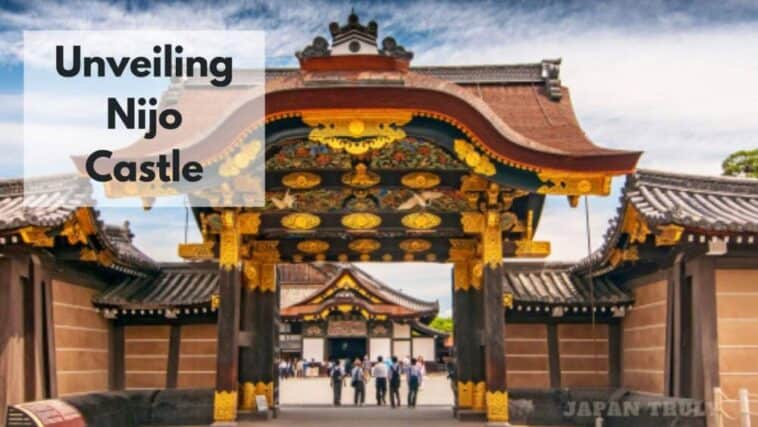Here’s everything you need to know about Nijo Castle. Check it out!
Nestled in the heart of Kyoto stands Nijo Castle, a breathtaking testament to Japan’s historical grandeur and architectural finesse.
Built in 1603 as the official residence of Tokugawa Ieyasu, the first shogun of the Edo Period, this castle not only served as a symbol of power but also acted as a pivotal site for the Japanese rulers.
Its meticulously designed structures and interiors depict a rich narrative of Japan’s feudal history, making it an invaluable cultural gem.

The expansive grounds of the castle and its well-preserved buildings offer a captivating journey through the past.
Visitors can walk through the same halls that once echoed with the footsteps of shoguns and their samurai.
The opulent Ninomaru Palace, with its intricate woodwork and gilded embellishments, contrasts with the functional simplicity of the Honmaru Palace.
The unique ‘nightingale floors’, designed to chirp like birds when stepped upon, functioned as a medieval security system alerting occupants to the presence of intruders.
This castle is not just a static monument; it’s a silent storyteller of the shogunate era.
Beyond the architectural marvels, the gardens of Nijo Castle embody the tranquil beauty synonymous with Japanese landscape design.
With the change of seasons, these meticulously cultivated gardens transform, offering a kaleidoscope of natural beauty that enchants visitors year-round.
The historical significance and natural splendor of Nijo Castle make it a must-visit destination for anyone seeking to experience the essence of Kyoto.
Key Takeaways
- Nijo Castle is an architectural and historical treasure of Kyoto.
- The castle provides an immersive experience of Japan’s feudal and shogunate history.
- Its gardens are a vivid showcase of Japanese seasonal changes and landscape design.
Page Contents
Exploring the Magnificent Nijo-jo Castle
Nijo-jo Castle, a stunning testament to Japan’s rich history, showcases the grandeur of the Edo Period through its breathtaking architecture and serene gardens. Here, visitors can immerse themselves in the legacy of the Tokugawa shogunate.
The Historical Significance of Nijo Castle
As the former residence of Tokugawa Ieyasu, the first shogun of the Edo Period, Nijo Castle stands as a monument to the power and influence of the Tokugawa shogunate.
Constructed in 1603, this imposing structure has been a pivotal witness to pivotal events in Japanese history, including the eventual relinquishment of shogunate power in favor of the emperor during the Meiji Restoration.
- Related: Things To Do In Himeji
Architectural Marvels of Nijo Castle
The splendor of Nijo Castle’s architecture is immediately apparent with the striking Karamon Gate, a classic example of shogunate grandeur.
Further inside, the Ninomaru and Hōnmaru palaces offer insights into the opulence of the time with their elaborate wood carvings and intricate Nightingale Floors, designed to sing at the slightest step to protect the shogun from clandestine attacks.
Cultural Treasures within the Nijo Castle Walls
Nijo-jo Castle is not just a fortress, but a cultural epicenter housing countless Japanese art treasures.
Visitors can marvel at the masterworks of the Kano School, still vibrant in the Nijo-jo Castle Painting Gallery, where exquisite wall paintings and murals reflect historical and natural themes.
A Stroll through Nijo Castle’s Gardens
The castle’s expansive gardens are as compelling as its interiors.
Ninomaru Garden, designed by the famous landscape architect Kobori Enshu, is a stunning example with its tranquil pond and carefully placed stones.
The garden also boasts a splendid display of cherry blossoms and plum orchards, which bloom splendidly, painting the landscape in vibrant hues.
Visitor Information
For those planning to include Nijo Castle in their Kyoto itinerary, the site is easily accessible via the Tozai Line or Karasuma Line of the Kyoto subway.
Information for guided tours, luggage storage, and the availability of a gift shop can be found at the entrance.
To ensure a smooth visit, especially during COVID-19 times, checking the latest visitor guidelines beforehand is advisable.
- Related: Must-visit Castles In Japan
Beyond Nijo Castle: A Glimpse of Kyoto
Stepping out from the historical walls of Nijo Castle, I find myself surrounded by Kyoto’s abundant cultural treasures and natural beauty. Keen to share what lies beyond, I’ll guide you through key attractions, cultural experiences, and travel tips that will enhance your Kyoto adventure.
Nearby Attractions and Landmarks At Nijo Castle
Just a stone’s throw away from Nijo Castle, the Kyoto Imperial Palace stands as a testament to the city’s regal past.
A trip to the Kinkaku-ji, or Golden Pavilion, reveals a magnificent structure adorned with gold leaf, shimmering across the pond it overlooks.
Venturing further, one must not miss the gates of Fushimi Inari Taisha, famed for its thousands of vermilion torii gates snaking up Mount Inari.
- Kiyomizu-dera Temple and its wooden stage offer panoramic views of Kyoto, especially breathtaking during cherry blossom season.
- The Arashiyama Bamboo Grove is a surreal escape, with towering bamboo stalks whispering in the wind.
Nijo Castle: FAQs
In this section, I answer the most common queries about Nijo Castle, providing insights into its historical value, attractions to see, fees, recommended visit duration, and available tours, along with highlighting features of the gardens.
What is the historical significance of Nijo Castle?
Nijo Castle stands as a testament to the power of the Tokugawa shogunate during Japan’s Edo period. Completed by Tokugawa Ieyasu’s grandson in 1626, it has witnessed key events like the declaration of the restoration of imperial rule in 1867. This site, a UNESCO World Heritage, embodies Japan’s feudal era’s political and social transformations.
Can you give tips on what to see inside Nijo Castle?
Inside the castle, the main attraction is the Ninomaru Palace with its ornate sliding doors and famous ‘nightingale floors’ designed to chirp when walked upon, alerting residents to intruders. I recommend not missing the Karamon Gate, which features intricate woodwork and gold leaf details.
What are the admission fees for Nijo Castle?
The admission fees for the castle are subject to change, but current pricing can be found in the provided link here. Please ensure to check this reference for the most up-to-date information before planning your visit.
How much time should one allocate for a visit to Nijo Castle?
I suggest allocating at least two to three hours to fully appreciate the castle’s architecture, history, and the extensive gardens. This should give you enough time to explore without feeling rushed.
Are there guided tours available at Nijo Castle?
Yes, guided tours are available at Nijo Castle. These tours offer a comprehensive look at the castle’s history and significant features, adding depth to your visit.
What are some must-see features in the gardens of Nijo Castle?
The gardens of Nijo Castle are a spectacle. They feature ornamental stones, manicured trees, and tranquil ponds.
The Seiryu-en Garden area is particularly notable. It has two tea houses and a large pond. This spot is picturesque in spring when the cherry blossoms are in full bloom.
My writing focuses on the various aspects of Japanese lifestyle, from traditional tea ceremonies and flower arrangement to modern fashion trends and pop culture. Through my articles, I aim to share my passion for Japan and provide readers with a glimpse into the rich and diverse world of Japanese culture.
I believe that the key to understanding Japanese lifestyle is to appreciate the balance between tradition and innovation. While Japan has a rich cultural heritage that dates back centuries, it is also a country that is constantly evolving and embracing new ideas and technologies.
Whether you’re interested in learning about the latest fashion trends in Tokyo, or want to explore the ancient art of calligraphy, my writing will take you on a journey through the many facets of Japanese lifestyle. So join me as we explore the beauty and complexity of this fascinating culture together!





